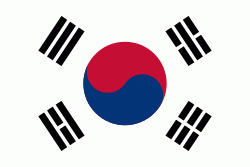Cheongju International Airport (Cheongju International Airport)
Cheongju International Airport is an international airport in Cheongwon-gu, Cheongju, South Korea. It also serves the cities of Daejeon and Sejong. In 2018, 2,453,649 passengers used the airport. It also houses the 17th fighter wing of the ROKAF. There is a railway station next to the airport, called Cheongju Airport station, which is on the Chungbuk Line.
Cheongju International Airport is located at Ipsang-ri (a township), Naesu-eup (읍; town), Cheongwon-gu, Cheongju, Chungcheongbuk-do. A railway station is located nearby. It opened as a military airbase in September 1978, and in 1984, international airport construction began. The construction was completed in December 1996, and it was opened as Cheongju International Airport on April 28, 1997. During the mid 80's, Cheongju was selected as a possible site for Korea's main international airport before Incheon became the preferred location. It can process 1.23 million people from domestic flights and 1.15 million people from international flights annually, and the parking lots can hold 770 vehicles. In addition, airplanes can operate 196,000 times a year. There used to be flights to Busan and Saipan, but they were stopped due to low ridership. Currently, there are domestic flights to Jeju and international flights to China, Japan, Taiwan, and Thailand. Because Cheongju Airport is sharing with military, taking photograph or video of apron, runway and military facility is strictly prohibited.
Cheongju International Airport is located at Ipsang-ri (a township), Naesu-eup (읍; town), Cheongwon-gu, Cheongju, Chungcheongbuk-do. A railway station is located nearby. It opened as a military airbase in September 1978, and in 1984, international airport construction began. The construction was completed in December 1996, and it was opened as Cheongju International Airport on April 28, 1997. During the mid 80's, Cheongju was selected as a possible site for Korea's main international airport before Incheon became the preferred location. It can process 1.23 million people from domestic flights and 1.15 million people from international flights annually, and the parking lots can hold 770 vehicles. In addition, airplanes can operate 196,000 times a year. There used to be flights to Busan and Saipan, but they were stopped due to low ridership. Currently, there are domestic flights to Jeju and international flights to China, Japan, Taiwan, and Thailand. Because Cheongju Airport is sharing with military, taking photograph or video of apron, runway and military facility is strictly prohibited.
| IATA Code | CJJ | ICAO Code | RKTU | FAA Code | |
|---|---|---|---|---|---|
| Telephone | +82-43-210-6114 | Fax | |||
| Home page | Hyperlink |
Map - Cheongju International Airport (Cheongju International Airport)
Map
Country - South_Korea
 |
 |
| Flag of South Korea | |
The Korean Peninsula was inhabited as early as the Lower Paleolithic period. Its first kingdom was noted in Chinese records in the early 7th century BCE. Following the unification of the Three Kingdoms of Korea into Silla and Balhae in the late 7th century, Korea was ruled by the Goryeo dynasty (918–1392) and the Joseon dynasty (1392–1897). The succeeding Korean Empire (1897–1910) was annexed in 1910 into the Empire of Japan. Japanese rule ended following Japan's surrender in World War II, after which Korea was divided into two zones; a northern zone occupied by the Soviet Union and a southern zone occupied by the United States. After negotiations on reunification failed, the southern zone became the Republic of Korea in August 1948 while the northern zone became the communist Democratic People's Republic of Korea the following month.
Currency / Language
| ISO | Currency | Symbol | Significant figures |
|---|---|---|---|
| KRW | South Korean won | â‚© | 0 |
| ISO | Language |
|---|---|
| EN | English language |
| KO | Korean language |















